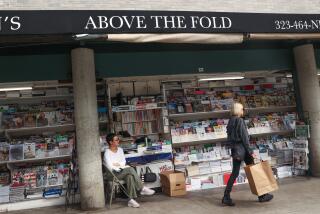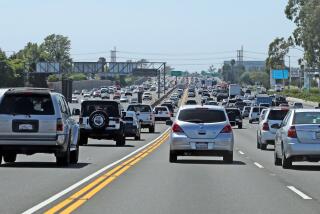Digital billboards have nearly tripled along California freeways — and state officials are proposing more

- Share via
Reporting from Sacramento — Once a rare sight, electronic billboards that flash new ads every few seconds have sprouted up by the hundreds along California freeways in recent years, much to the alarm of environmentalists and traffic-safety experts.
In the nearly eight years since Jerry Brown was elected governor, his administration has nearly tripled the number of commercial digital signs permitted along highways, from 125 to 366, records show.
Now the Brown administration thinks California can make a profit, sending lawmakers a report that says it is “feasible” to allow commercial ads on state-operated electronic message signs along freeways in a test program that it estimates would bring in millions of dollars.
If successful, the pilot program could lead to ads for commercial products on many of the 904 state-operated message signs that currently are limited to flashing traffic information, road hazard warnings and Amber alerts on abducted children, according to a feasibility study sent by the California Department of Transportation.
The study led to the introduction last week of legislation to authorize a five-year pilot program pushed by lobbyists for the influential billboard companies that would benefit from the change. Meanwhile, cities and counties have launched efforts to kill the measure, fearing it would take away their power to control signage.
The bill by Democratic Assemblymen Kevin Mullin of South San Francisco and Rob Bonta of Alameda would exempt 25 digital billboards from the current state ban on such signs in public rights-of-way along freeways.
“This pilot project will provide the traveling public with clear, easy to understand messaging including public safety alerts and disaster alerts as compared to current electronic signs,” Mullin said, adding he wants to “make sure that we are taking full advantage of evolving technology and reaping the potential benefits of revenue that is generated in the process.”
Opponents fear the expansion will be one of the governor’s last actions before he leaves office in January, though Brown has not stated a position on the bill.
Patrick Frank, a Los Angeles resident who is president of the Coalition to Ban Billboard Blight, is among those alarmed by the spike in electronic billboards and the potential for more to come.
“It’s the world’s worst idea,” Frank said. “It’s crazy. It’s out of control. It’s not financially necessary. We don’t need advertising on our freeways.”
The test program would generate $10.2 million in revenue for the state over the first four years, according to the Caltrans analysis. But Frank notes the state is already projecting a large surplus next year, with almost $14 billion in its rainy day budget fund.
He said the new digital billboards would be an eyesore.
“We’re completely against it for aesthetic reasons, among others,” Frank said.
The proposal is also opposed by Jerry Wachtel, a traffic safety expert who has done research for Caltrans and the National Cooperative Highway Research Program, and who believes the digital signs would make California freeways more dangerous.
“It’s a horrible idea,” Wachtel said. “There is no doubt that it would add to distracted driving. It takes the driver’s eyes off the road. And depending upon how effective the beer ad is, it may take the driver’s mind off the road as well.”
Billboard firms and their trade group spent $2 million lobbying in Sacramento during the last decade. They also contributed $4.52 million to political campaigns during that period. The contributions include a combined $100,000 to Brown’s campaigns for governor from Foster Interstate Media Inc., Clear Channel Outdoor and CBS Outdoor, now Outfront Media.
Clear Channel and CBS also contributed billboard advertising worth a combined $193,000 to Brown’s campaign for Proposition 30, the governor’s 2012 ballot measure that temporarily raised taxes on the wealthy.
Coverage of California politics »
Mullin and Bonta have received a combined $13,500 in contributions from the Foster firm for their reelection campaigns this year and in 2016.
Supporters of the bill to launch the pilot program include digital sign firms Outfront Media and Intelligent Sign Network LLC, which has ties to Foster Interstate Media, the donor to Brown, Mullin and Bonta.
Brown declined to comment on the latest proposals through a spokesman, who referred calls to transportation agency officials.
Caltrans spokesman Mark Dinger said traffic safety issues would be paramount for the agency if a test program is tried.
“Although the pilot would be intended to assess revenue‑generating possibilities from the advertising, Caltrans’ primary concern would be any potential for a safety impact on the motoring public,” Dinger said. “Any such impact would cause the immediate and permanent discontinuation of the program.”
The legislation has already drawn opposition from the League of California Cities.
“The bill is purported to be a five-year pilot measure, when in fact it is a secretly negotiated deal between a large billboard company and the Legislature,” said Bellflower City Manager Jeffrey L. Stewart, who declined to identify the firm he thinks will benefit. He added that the measure “would serve to strip all local control and revenue from animated signs near freeways.”
Of the 366 digital billboards already permitted by Caltrans near freeways, 103 are in Los Angeles County, up from 66 allowed in the county in 2013, according to state data.
Caltrans officials say their policy is to approve permits for digital billboards on private property as long as the structures comply with state standards.
The program outlined in the Brown administration report would put commercial ads on 25 digital billboards that would replace message signs operated by the state in Los Angeles, San Francisco and Sacramento, according to the Caltrans study delivered to legislators last month.
The three urban areas were picked as “the highest three revenue markets in the State,” the Caltrans report says.
The agency’s 160-page report says a successful test could result in commercial ads being extended to more of the 904 changeable message signs operated by the state.
Los Angeles County has, by far, the most state-operated digital signs of any county in the state, with 126. Beyond the issue of distracting drivers, Wachtel said research indicates that putting commercial ads on the signs lessen their effectiveness in warning motorists of traffic hazards and other government information.
“The problem, as has been discovered in some studies, is that when official traffic signs convey advertising, motorists tend to begin to dismiss them,” he said.
The Caltrans report says that there are “significant challenges” to setting up a test program, including the need to change state law and to get the federal government to waive a ban on electronic signs in freeway rights-of-way.
The Mullin-Bonta bill, which is scheduled for a hearing Tuesday in the Senate transportation committee, would remove an obstacle in state law.
Supporters say the system can be designed in a way that might get approval from officials in Washington, D.C., although the Federal Highway Administration rejected a proposal last year to put ads on state-operated freeway traffic signs in Texas.
Frank, the L.A. based activist, is not just concerned about any expansion. The proliferation of digital signs along freeways in recent years has also affected his opinion of Brown.
“I’m really disappointed because I like Jerry Brown in a lot of respects, and the fact that this is happening on his watch doesn’t speak well,” Frank said.
Twitter: @mcgreevy99
More to Read
Get the L.A. Times Politics newsletter
Deeply reported insights into legislation, politics and policy from Sacramento, Washington and beyond. In your inbox three times per week.
You may occasionally receive promotional content from the Los Angeles Times.











